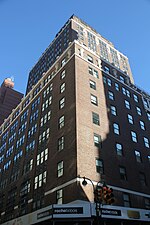Activist Women's Voices
The Activist Women's Voices collection is an oral history project of 35 women activists who worked in community-based organizations in the New York City area. The project covers the period from 1995 to 2000 and was a project of The City University of New York (CUNY) Graduate Center's Women's Studies Program and Center for the Study of Women. The digitized collection is made up of women from a diverse cross-section of cultural and ethnic social service organizations including activists from Arab-American, Haitian, Hispanic, African-American, and Asian-American communities. It is held at the Mina Rees Library, within the Graduate Center's B. Altman and Company Building.
Excerpt from the Wikipedia article Activist Women's Voices (License: CC BY-SA 3.0, Authors).Activist Women's Voices
5th Avenue, New York Manhattan
Geographical coordinates (GPS) Address Website Nearby Places Show on map
Geographical coordinates (GPS)
| Latitude | Longitude |
|---|---|
| N 40.74852 ° | E -73.98361 ° |
Address
CUNY Graduate School and University Center
5th Avenue 365
10016 New York, Manhattan
New York, United States
Open on Google Maps






